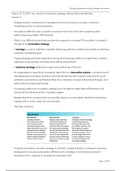Changing Business through Strategic Innovation
Pisano, G. P. 2015. You need an innovation strategy. Harvard Business Review.
Session 1
- Despite massive investments of management time and money, innovation remains a
frustrating pursuit in many businesses.
- Innovations often fail, and successful innovators have had a hard time sustaining their
performance (e.g. Nokia, HP, Polaroid).
- Why is it so difficult to build and maintain the capacity to innovate? The problem is rooted in
the lack of an innovation strategy.
- A strategy is a set of coherent, mutually reinforcing policies or behaviours aimed at achieving
a specific competitive goal.
- A good strategy promotes alignment among diverse groups within an organisation, clarifies
objectives and priorities, and helps focus efforts around them.
- A business strategy defines the scope and positioning of the firm.
- An organisation's capacity for innovation stems from an innovation system: a coherent set of
interdependent processes and structures that dictate how the company searches for novel
problems and solutions, synthesises ideas into a business concept and product designs, and
selects which projects get funded.
- A company without an innovation strategy won’t be able to make trade-off decisions and
choose all the elements of the innovation system.
- Despite that firms can learn from one another, there is no one system that fits all companies
equally well or works under all circumstances.
- The idea in picture:
- A clearly articulated innovation strategy is one that's closely linked to a company's business
strategy and core value proposition. Without such a strategy, most initiatives aimed at
boosting a firm's capacity to innovate are doomed to fail.
Page 1 of 20
, Changing Business through Strategic Innovation
- A robust innovation strategy should answer the following questions:
• How will innovation create value for potential customers?
• How will the company capture a share of the value its innovations generate?
• What types of innovations will allow the company to create and capture value, and what
resources should each type receive?
- Unless innovation induces potential customers to pay more, saves them money, or provides
some larger societal benefit like improved health or cleaner water, it is not creating value.
- Choosing what kind of value your innovation will create and then sticking to that is critical,
because the capabilities required for each are quite different and take time to accumulate.
- Value-creating innovations attract imitators as quickly as they attract customers - rarely is
intellectual property sufficient to block these rivals. As imitators enter the market, they create
price pressures that can reduce the value that the original innovator captures.
- Companies must think through what complementary assets, capabilities, products, or services
could prevent customers from defecting to rivals and keep their own position in the
ecosystem strong.
- One of the best ways to preserve bargaining power in an ecosystem and blunt imitators is to
continue to invest in innovation.
- In thinking about innovation opportunities, companies have a choice about how much of their
efforts to focus on technological innovation and how much to invest in business model
innovation. They can think about this using the Innovation Landscape Map, which
characterises innovation along two dimensions: the degree to which it involves a change in
technology and the degree to which it involves a change in business model - suggesting four
quadrants of innovation.
- The innovation landscape map:
Page 2 of 20
, Changing Business through Strategic Innovation
- Routine innovation builds on a company’s existing technological competences and fits with
its existing business model, so also its customer base (e.g. Apple iPhone).
- Disruptive innovation requires a new business model but not necessarily a technological
breakthrough. For that reason, it challenges, or disrupts, the business models of other
companies (e.g. Google's Android disrupts Apple and Microsoft).
- Radical innovation is the polar opposite of disruptive innovation. The challenge is purely
technological (e.g. genetic engineering/biotechnology as an approach to drug discovery).
- Architectural innovation combines technological and business model disruptions (e.g.
Kodak with digital photography).
- A company’s innovation strategy should specify how the different types of innovation fit into
the business strategy and the resources that should be allocated to each. In much of the
writing on innovation today, radical, disruptive, and architectural innovations are viewed as
the keys to growth, and routine innovation is denigrated as myopic at best and suicidal at
worst. That line of thinking is simplistic.
- An explicit innovation strategy helps firms understand which practices might be a good fit for
your organisation. It helps firms navigate the inherent trade-offs.
- Crowdsourcing is the idea that rather than relying on a few experts (perhaps your own
employees) to solve specific innovation problems, you open up the process to anyone (the
crowd). This can lead to faster, more-efficient, and more-creative problem solving.
- Crowdsourcing, like other innovation practices, involves trade-offs. It is a tool whose strength
(exploiting large numbers of diverse problem solvers) is a benefit in some contexts (highly
diffused knowledge base, relatively inexpensive ways to test proposed solutions, modular
system) but not in others (concentrated knowledge base, expensive testing, system with
integral architectures).
- A demand-pull approach involves finding customers’ highly challenging problems and then
figuring out how the company’s cutting-edge technologies can solve them.
- A supply-push approach is developing a technology and then finding or creating a market.
- Four tasks in creating and implementing an innovation strategy:
1. Answer the question how are we expecting innovation to create value for customers and for
our company?
2. Create a high-level plan for allocating resources to the different kinds of innovation.
3. Manage trade-offs
4. Recognising that innovation strategies must evolve
- Any strategy represents a hypothesis that is tested against the unfolding realities of markets,
technologies, regulations, and competitors.
Page 3 of 20





